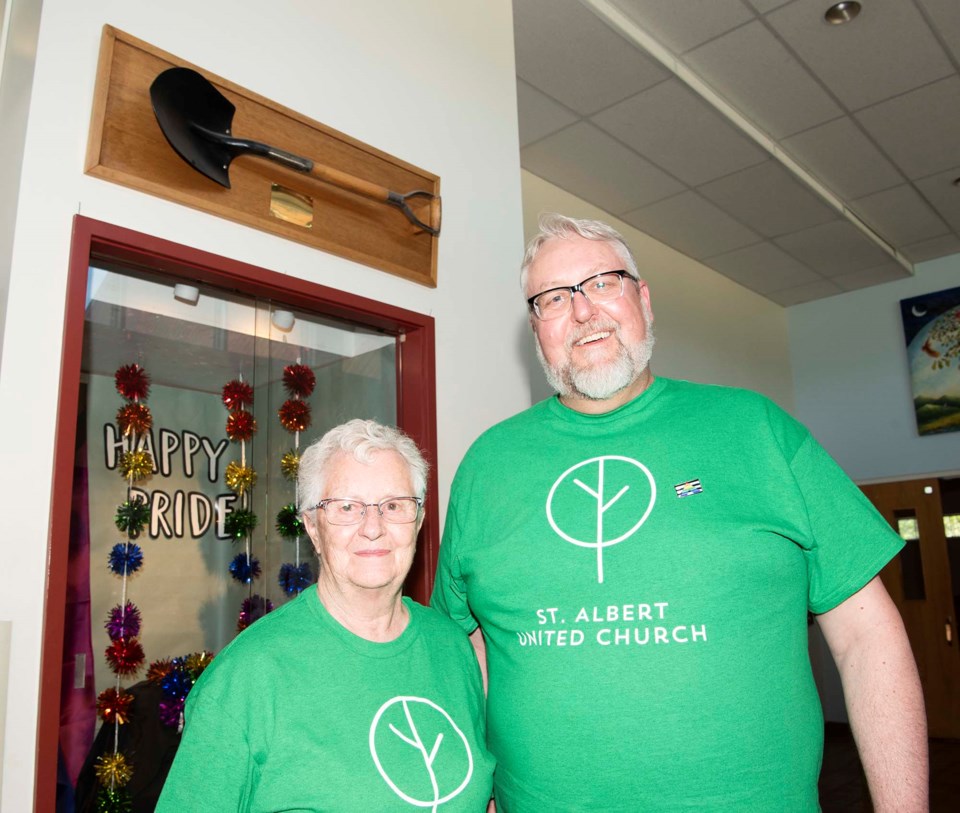St. Albert’s Church on the Trail has turned 70.
About 100 people were at the St. Albert United Church at 20 Green Grove Dr. June 23 to mark the church’s 70th anniversary with cake, hot dogs, and hamburgers. Many wore celebratory green shirts specially made for the occasion.
The United Church is a Christian denomination that emphasizes inclusion regardless of race, ability, or sexual and gender orientation, said St. Albert United church council chairperson Troy Sartison. It fundraises for groups such as the Bissel Centre, runs blanket exercises for truth and reconciliation, and hosts the St. Albert Rotary Music Festival.
The purple church?
St. Albert United started in 1954, historian David Geddes writes in The Church on the Hill. Noting that about 15 per cent of St. Albert was non-Catholic, residents William D. Cuts (namesake of W.D. Cuts Junior High) and H. “Bert” Sumner organized a meeting on Feb. 15 at the home of Frank Ball (which coincidentally stood just south of where the church stands today) to see if there was interest in forming a Protestant congregation. The 63 people in attendance agreed to rally under the United Church banner, as a slim majority of the attendees were members of that group.
Some 150 people from St. Albert and Sturgeon County were at the church’s first service at the Club Mocombo on March 7, 1954, Geddes notes. (Club Mocombo burned down in 2000, and once stood where the Boston Pizza on Grenier Place is today.) Future Alberta lieutenant governor Lois Hole served as the congregation’s organist.
The congregation broke ground on its church building on April 29, 1956, at 20 Green Grove Dr., Geddes writes. The shovel used in that groundbreaking ceremony would be used again in 1983 when the congregation expanded the church building, and is now on display in the church’s lobby.
St. Albert United Church council member Susan Waldie said she joined St. Albert United in 1971 during the tenure of Rev. Leonard J. Musto, the congregation’s longest-serving minister to date. Back then, the church had a gravel parking lot and a big air raid siren next to it, and had to hold two Sunday services a week to accommodate all its members.
“There were no streetlights in St. Albert,” she recalled, and maybe five blocks of the now-sprawling Lacombe Park built.
Waldie said St. Albert United became known as “the Purple Church” in around 1973 after Rev. Musto told the congregation that the church needed a new coat of paint. A church member said he could provide some leftover paint, but the only colour he had was purple. Geddes notes that the now purple-painted church became something of a tourist attraction in town until it was repainted in 1979.
Modern times
Waldie said the congregation has counted at least three St. Albert mayors (Anita Ratchinsky, Richard Plain, and Ronald Harvey) and many St. Albert Protestant/Public trustees amongst its members over the years.
2011 saw St. Albert United unveil an outdoor labyrinth for public use and a solar array — one that for many years was the biggest in St. Albert, the Gazette’s archives show.
Sartison said it was tough to say what St. Albert United would look like in 30 years, given its shrinking size. The congregation’s main focus today was sustainability, as its membership had shrunk to about 150 families from its historic high of about 400.
“The quickest growing demographic when it comes to religious belief is ‘none at all,’” he said, so the church has stepped up its community outreach to try and stay relevant.
The St. Albert United Church gathers for worship Sundays at 10 a.m. Visit www.stalbertunited.com for details.




